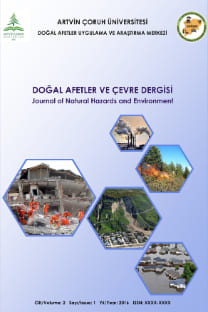Batı Karadeniz Bölgesinde Kuraklık İndisleri Üzerine Trend Analizi Uygulanması
Application of Trend Analysis on Drought Indices in the West Black Sea Region
___
- Ali Z., Hussain I., Faisal M., Nazir H.M., Abd-el Moemen M., Hussain T., Shamsuddin S., (2017), A Novel Multi-Scalar Drought Index for Monitoring Drought: The Standardized Precipitation Temperature Index, Water Resources Management, 31, 4957– 4969.
- Anisfeld S.C., (2010). Water Resources, Island Press, Washington DC, The United States of America, 352ss.
- Çaldağ B., Şaylan L., Toros H., Sırdaş S., Bakanoğulları F., (2004), Drought analysis in northwest Turkey, Role of Multipurpose Agriculture in Sustaining Global Environment, 20 - 24, October, Udine, Italy, ss.169-179.
- de Martonne E., (1926), Une nouvelle fanction climatologique: l’indice d’aridité. La Météorologie, 2, 449–458.
- Demir V., (2018), Karadeniz Bölgesi yağışlarının trend analizi, Yüksek Lisans Tezi, Karatay Üniversitesi, Konya.
- Doğan S., Berktay A., Singh V.P., (2012), Comparison of multi-monthly rainfall based drought severity indices, with application to semi-arid Konya closed basin, Turkey, Journal of Hydrology, 470- 471, 255-268.
- Gocic M., Trajkovic S., (2013), Analysis of changes in meteorological variables using Mann-Kendall and Sen’s slope estimator statistical tests in Serbia, Global and Planetary Change, 100, 172–182.
- Gümüş V., Başak A., Oruç N., (2016), Standartlaştırılmış yağış indeksi (SYİ) yöntemi ile Şanlıurfa istasyonunun kuraklık analizi, Harran Üniversitesi Mühendislik Dergisi, 01(2016), 36-44.
- Gumus V., Algın H.M., (2017), Meteorological and hydrological drought analysis of the Seyhan−Ceyhan River Basins, Turkey, Meteorological Applications, 24(1), 62-73.
- İrvem A., Özbuldu M., Çıplak C., (2018), Seyhan Göksu-Himmetli alt-havzasının akım verileri ile kuraklık analizi. Journal of Agricultural Faculty of Mustafa Kemal University, 23(2), 148-157.
- Hangshing L., Dabral, P.P., (2018), Multivariate Frequency Analysis of Meteorological Drought Using Copula, Water Resources Management, 32(5), 1741-1758.
- Kahya E., Kalayci S., (2004), Trend analysis of streamflow in Turkey, Journal of Hydrology, 289(1-4), 128-144
- Keskin M.E., Terzi Ö., Taylan E.D., Yılmaz A.G., (2007), Isparta bölgesi meteorolojik kuraklık analizi, I. Türkiye İklim Değişikliği Kongresi (TİKDEK), 11-13 Nisan İstanbul, ss.350-359.
- McKee T.B., Doesken N.J., Kleist J., (1993), The relationship of drought frequency and duration to time steps, Preprints, 8th Conference on Applied Climatology, January 17–22, Anaheim, California, ss.179–184.
- Mondal A., Kundu S., Mukhopadhyay A., (2012), Rainfall trend analysis by Mann Kendall test: A case study of NorthEastern part of Cuttack District, Orissa, International Journal of Geology, 2,70- 78.
- Nistor M.M., (2016), Spatial distribution of climate indices in the Emilia‐Romagna region, Meteorological Applications, 23, 304- 313.
- Pamuk G., Özgürel M., Topçuoğlu K. (2004), Standart yağış indeksi (SPI) ile Ege bölgesinde kuraklık analizi. Ege Üniversitesi Ziraat Fakültesi Dergisi, 41(1), 99-106.
- Partal T., Kahya E., (2006), Trend analysis in Turkish precipitation data, Hydrological Processes, 20, 2011-2026.
- Pellicone G, Caloiero T., Guagliardi I., (2018), The De Martonne aridity index in Calabria (Southern Italy), Journal of Maps, 15(2), 788-796.
- Petel N.R., Chopra P., Dadhwal V.K., (2007), Analyzing spatial patterns of meteorological drought using standardized precipitation index, Meteorological Applications, 14, 329-336.
- Saplıoğlu K., Çoban E., (2013), Karadeniz bölgesi yağış serilerinin trend analizi, VII. Ulusal Hidroloji Kongresi 26 -27 Eylül, Süleyman Demirel Üniversitesi, Isparta, ss.500-512.
- Selçuk D., (2017), Kızılırmak havzasında hidrometeorolojik parametrelerle kuraklık analizi ve tahmini, Yüksek Lisans Tezi, OMÜ Fen Bilimleri Enstitüsü, Samsun.
- Şaylan L., Durak M., Şen O., (1997), Kuraklık ve etkileri, Meteorolojik Karakterli Doğal Afetler Sempozyumu, Bildiriler Kitabı, 7-9 Ekim, Ankara, ss.433-444.
- Tian J., Liu J., Wang J., Li C., Nie H., Yu, F., (2017), Trend analysis of temperature and precipitation extremes in major grain producing area of China. International Journal of Climatology, 37(2), 672-687
- Topçuoğlu K., Mengü G.P., Anaç S., (2008), Ege Bölgesi meteorolojik kuraklık analizi, 5. Dünya Su Forumu Türkiye Bölgesel Su Toplantıları-Konya Kapalı Havzası Yeraltısuyu ve Kuraklık Konferansı, 11-12 Eylül, Konya, Türkiye, ss.175-184.
- Westra S., Alexander LV., Zwiers, F.W. (2013), Global increasing trends in annual maximum daily precipitation. Journal of Climate, 26, 3904-3918.
- Zhang Q., Xu C.Y., Zhang Z., (2009), Observed changes of drought/wetness episodes in the Pearl River basin, China, using the standardized precipitation index and aridity index, Theoretical and Applied Climatology, 98, 89–99.
- ISSN: 2528-9640
- Yayın Aralığı: Yılda 2 Sayı
- Başlangıç: 2015
- Yayıncı: Artvin Çoruh Üniversitesi Doğal Afetler Uygulama ve Araştırma Merkezi
Hakan ERSOY, Murat KARAHAN, Hasan Hüseyin ÖZTÜRK
Uluabat Gölü Noktasal Kirletici Kaynaklar ve Kirlilik Yükleri
Saadet HACISALİHOĞLU, Feza KARAER
Sürdürülebilirliğin Temel Taşı: Ekolojik Ayak İzi
Ece TUĞBA MIZIK, Zehra YİĞİT AVDAN
Yerel Yönetimler İçin Karbon Ayak İzinin Belirlenmesi: Ümraniye Belediyesi Örneği
B. Hande GÜRSOY HAKSEVENLER, G. Nur ÇELİK ONAT, Begüm AKPINAR, Tuğba BEDEL
Orman Yangın Yönetiminde Etkili Bir Karar Destek Sisteminin Kavramsal Çerçevesi
KADİR ALPEREN COŞKUNER, Ertuğrul BİLGİLİ
Farklı Malzemeler ve Geosentetiklerin Yol Dolgusu Güvenliğine ve Davranışına Etkileri
Yusufeli Barajı Antropojenik Etkilerinin Peyzaj Planlama Açısından Değerlendirilmesi
Taşkın Frekans Analizinde Eşik Üstü Pikler Yönteminin Seyhan Havzası’nda Uygulanması
Perde-Çerçeve Sistemlerde Rijitlik ve Kayma Merkezi
